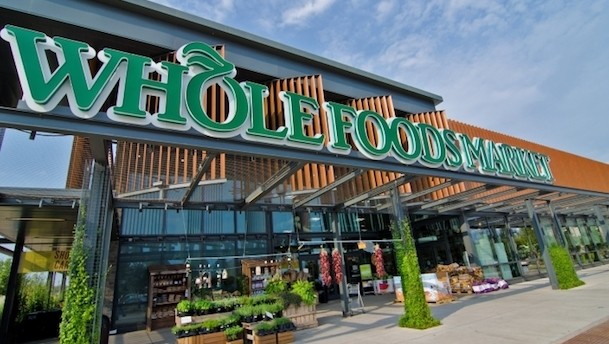'Amazon has moved squarely onto the turf of traditional supermarkets and poses a much more significant threat,’ says analyst as ecommerce giant pays $13.7bn for Whole Foods

As David Portalatin VP, industry analysis, food, at The NPD Group noted in a statement released this morning, “Amazon is already the biggest e-commerce player in America. And it has become so pervasive in retail that 42% of consumers bought something from Amazon last year... and a full 60% of Millennials are Amazon buyers.
“By contrast, just 20% of American consumers bought at least one item from Whole Foods last year. And that’s down 3 percentage points from the prior 12 months. But among Millennials, the number is substantially higher: 24%. That’s extraordinary penetration for a supermarket chain with just 431 [US] stores [editor's note: globally, Whole Foods operates 465 stores, the vast majority of which are in the US. Latest figures show there are c.443 US stores].
“The deal now gives Amazon control of those stores, nearly all of which are in neighborhoods that are more affluent and younger than America as a whole. Those stores solve much of Amazon’s 'last-mile' delivery challenge for fresh groceries, which is arguably the biggest single reason that Amazon has not been able to make a dent in the grocery shopping of the 60% of Millennials who already buy other items from Amazon.
“And of the people who already buy groceries through the Web, 52% of them are Amazon Prime members, according to research from The NPD Group. Those stores suddenly make it easier for those Prime members, who tend to purchase heavily through Amazon, to get access to fresh produce/foods.”
Neil Saunders: There is an inherent logic in the move
Neil Saunders, managing director of consultancy GlobalData Retail, also predicted the deal could be disruptive over the longer term, although the immediate impact may be less clear: "There is an inherent logic in the move which, in our view, brings benefits to both businesses."
While Amazon could have built up its presence organically, it would have been costly and time-consuming to scale up its grocery business, he said. "In our view, an online-only operation would also have suffered from perilously low margins and would have damaged Amazon's profitability as it scaled up. For Amazon, Whole Foods fulfills, at a stroke, its ambition to be a serious player in the grocery market."
A national bricks and mortar chain gives Amazon an established business that it can transform through its technology and supply chain expertise in addition to a well-known and well-regarded brand that can, ultimately, be sold across Amazon platforms, he added.
"Longer term, Whole Foods provides Amazon with a well-balanced and nicely distributed physical presence that allows it to offer click-and-collect and other services which are linked to the rest of its business. And there can be little doubt that Amazon will develop a proper online presence for Whole Foods which, at the moment, relies on third parties like Instacart for online ordering."
What's next for Amazon?
"The acquisition gives Amazon CEO Jeff Bezos a weapon to attract a customer he largely already caters to (the majority of PRIME members make > $100K per year), but if the goal is to fully compete against Wal-Mart (and the low-end), then could Dollar General be next on Amazon’s buying list to go after an arguably larger part of the U.S. population?"
Chuck Grom, analyst, Gordon Haskett
'Amazon has moved squarely onto the turf of traditional supermarkets'
For other grocers, meanwhile, argued Saunders, "the deal is potentially terrifying... Amazon has moved squarely onto the turf of traditional supermarkets and poses a much more significant threat. The only mitigation is that the more niche appeal of Whole Foods will, at least for the time being, limit the threat to other players."
That said, "a big problem for Whole Foods is that the brand is not delivering in areas like taste and food innovation," he observed. "And these are not Amazon's core areas of expertise, so the acquisition will not automatically remedy the issues.”
"Whole Foods enriches Amazon’s consumables platforms (Fresh, Now, and Pantry), and strengthens the Prime membership offer. Shopping Whole Foods through Alexa for 2-hour Prime Now delivery will soon be a reality. Amazon will elevate and combine convenience, value, and natural/fresh shopping.
"We also expect Amazon to install its technology at Whole Foods locations. This may include click-and-collect grocery pickup services and its Amazon Go automatic checkout technology. Both of these are being tested in Seattle today, and as they roll out it will accelerate the store’s trip flexibility."
Kantar Retail Senior Analyst Robin Sherk
Dr Kurt Jetta: Amazon’s white flag
However the fact that Amazon has chosen to acquire a bricks and mortar retailer could also be seen as effectively “raising the white flag on e-commerce grocery,” argued Dr Kurt Jetta, CEO of consumer packaged goods (CPG) market research firm TABS Analytics. He added that the deal would impact Target more than Kroger.
In terms of online grocery sales, "Amazon isn’t successful now, and wasn’t ever going to be successful," Jetta told FoodNavigator-USA. "I guess they realized that and that’s why they’ve been playing footsie with the whole brick-and-mortar—this [acquisition] basically confirms that."
Last year, Amazon opened several physical bookstores throughout the country, and is also testing a brick-and-mortar grocery concept in Seattle with its cashier-free Amazon Go store.
Looking at Amazon’s US grocery sales, the 30% year-over-year surge to $350m in Q1 2017, according to analysis by One Click Retail, is rapid but still a smudge in the $600bn plus grocery industry.
"Although industry revenue is only set to rise at an annualized rate of 0.8% over the five years to 2022, the transaction will allow the online retail giant to boost not only its grocery sales, but expand its brick-and-mortar presence,” IBISWorld industry analyst Madeline Hurley said.
"Amazon has learned that it cannot just rely on e-commerce to sell grocery, as seen first by Amazon Go and now its acquisition of Whole Foods. By linking Amazon behavior with everyday grocery, they create an unprecedented ability to cross-sell in both the Amazon and Whole Foods environments among consumers with plenty of money to spend."
Matt Sargent, SVP Retail, Magid
'Whole Foods is very weak in every area except the perimeter'
However, the CPG space may not be impacted as much as people may think, Jetta argued. “The market for CPG is lower and middle income consumers, and those two areas are already weak,” he said.
“There’s a huge drop off of purchasing from those people in both Whole Foods and Amazon. So for CPG—or Big Food in general—the effect is minimal,” he added. For center-store, affected parties are the “upscale bubble that buy organic and gluten-free,” he said.
Additionally, Jetta doesn’t see that big of an impact on other grocery stores. “Whole Foods is very weak in every area except the perimeter, and this deal does nothing to address that,” he said.
Market share, US food and grocery market, 2016:
• Whole Foods: 1.21%
• Amazon: 0.19%
• Walmart: 14.46%
• Kroger: 7.17%
• South Eastern Grocers: 3.89%
• Ahold Delhaize: 3.18%
• Albertsons: 4.50%
• Costco: 2.43%
• Publix: 2.25%
• Target: 2.12%
• HEB: 1.71%
• Dollar General: 1.16%
• Supervalu: 1.11%
• Seven & I Holdings: 1.08%
Source: GlobalData Retail estimates and analysis
Big changes, Jetta predicted, will be more in the supply chain and logistics arena. “If it’s going to hurt somebody, it would be Target. There is zero rationale for it to hurt Kroger, because the overlap in stores itself is so minimal."
But he added: ”You never want to underestimate the innovativeness of Amazon—maybe people give them way too much credit, but if there could be some crazy innovation they can implement at Whole Foods that changes things overnight—that’s the fun, exciting element of this deal."
"If selling Whole Foods is arguably the best strategy to address shareholder demands, how does John Mackey stay true to his enduring philosophies that created one of the most positively influential businesses in America, while complying with his legal obligations as the CEO of a public company?"
Michael Movitz, founder, The Movitz Group LLC
"This is now a huge question mark for who will lead as the organic retailer of the 21st century. Up until recently, Whole Foods created this industry and truly led it without question. But now, the game is flipping on its side."
Michael Joseph, CEO, founder, GreenChef
'Amazon-Whole Foods deal only further curtails consumer choices and raise prices'
As for consumers, there has been a mixed response, with some welcoming the deal and others fans calling the company a sell-out on its facebook page, and inviting friends to boycott the store.
According to Wenonah Hauter, executive director of grassroots advocacy group Food and Water Watch, the merger is a harmful one for consumers.
“Too few companies already exert outsized influence over our food choices. This is extreme consolidation of the food system in action, which will lead to higher prices, fewer choices for consumers, and bigger profits for billionaires like its owner, Jeff Bezos,” she said.
'Chronic underperformance'
Amazon’s announcementcomes two months after activist investors led by Jana Partners acquired 8.3% of Whole Foods’ stock, and urged the chain to take radical action to address its recent “chronic underperformance," a move prompting a flurry of speculation over a possible sale, with Amazon, Kroger and Albertsons all touted as potential suitors.
In the April 10 filing, the investors noted that Whole Foods’ same store sales had been in negative territory for more than a year and argued that it must re-engineer its “suboptimal and cost disadvantaged grocery procurement and distribution strategy.”
Seattle-based Amazon said the deal to acquire Whole Foods for $42 per share includes the net debt of the retailer, which has $15.8bn in annual sales.
“This partnership presents an opportunity to maximize value for Whole Foods Market’s shareholders, while at the same time extending our mission and bringing the highest quality, experience, convenience and innovation to our customers,” said Whole Foods co-founder and CEO, John Mackey, who will remain as CEO.
Whole Foods will continue to operate from its Austin, TX, HQ and its stores will remain under the Whole Foods Market brand.
“Millions of people love Whole Foods Market because they offer the best natural and organic foods, and they make it fun to eat healthy,” said Jeff Bezos, Amazon founder and CEO. “Whole Foods Market has been satisfying, delighting and nourishing customers for nearly four decades - they’re doing an amazing job and we want that to continue.”
The deal is expected to close during the second half of 2017.
Interested in how other grocery e-commerce players will react to the Amazon/Whole Foods deal? Check out our incredible lineup of speakers at FOOD VISION USA 2017 (Chicago, Nov 13-15), which includes PeaPod CMO Carrie Bienkowski.








